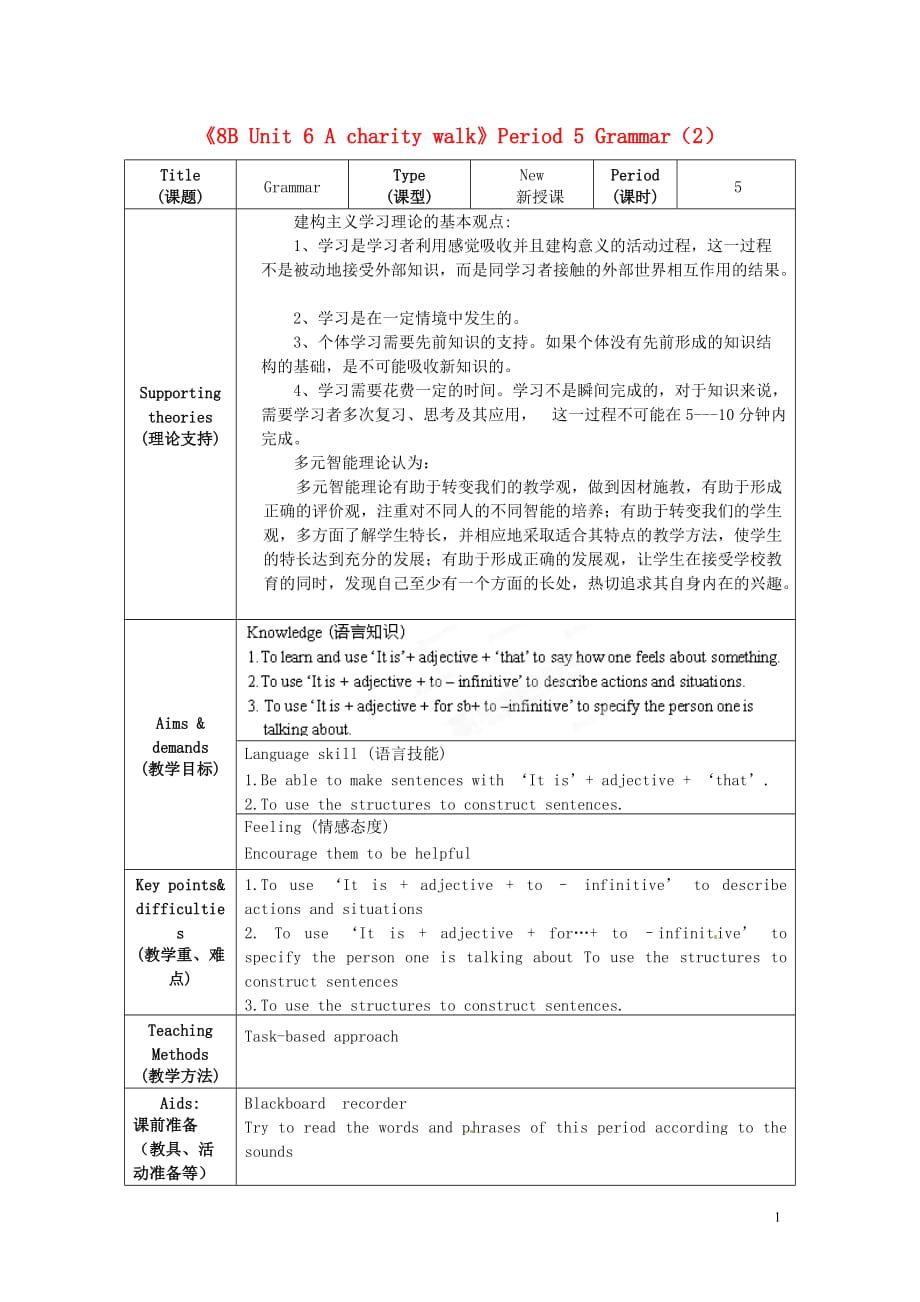《初級(jí)中學(xué)八年級(jí)英語(yǔ)下冊(cè)《8B Unit 6 A charity walk》Period 5 Grammar(2)教案 牛津版》由會(huì)員分享,可在線(xiàn)閱讀�,更多相關(guān)《初級(jí)中學(xué)八年級(jí)英語(yǔ)下冊(cè)《8B Unit 6 A charity walk》Period 5 Grammar(2)教案 牛津版(5頁(yè)珍藏版)》請(qǐng)?jiān)谘b配圖網(wǎng)上搜索��。
1����、
《8B Unit 6 A charity walk》Period 5 Grammar(2)
Title
(課題)
Grammar
Type
(課型)
New
新授課
Period
(課時(shí))
5
Supporting theories
(理論支持)
建構(gòu)主義學(xué)習(xí)理論的基本觀點(diǎn):
1、學(xué)習(xí)是學(xué)習(xí)者利用感覺(jué)吸收并且建構(gòu)意義的活動(dòng)過(guò)程��,這一過(guò)程不是被動(dòng)地接受外部知識(shí),而是同學(xué)習(xí)者接觸的外部世界相互作用的結(jié)果��。
2�����、學(xué)習(xí)是在一定情境中發(fā)生的����。
3、個(gè)體學(xué)習(xí)需要先前知識(shí)的支持�����。如果個(gè)體沒(méi)有先前形成的知識(shí)結(jié)構(gòu)的基礎(chǔ),是不可能吸收新知識(shí)的�����。
4�����、學(xué)習(xí)需要花費(fèi)一定的時(shí)間����。學(xué)
2、習(xí)不是瞬間完成的����,對(duì)于知識(shí)來(lái)說(shuō),需要學(xué)習(xí)者多次復(fù)習(xí)���、思考及其應(yīng)用�����, 這一過(guò)程不可能在5---10分鐘內(nèi)完成�����。
多元智能理論認(rèn)為:
多元智能理論有助于轉(zhuǎn)變我們的教學(xué)觀�,做到因材施教�,有助于形成正確的評(píng)價(jià)觀��,注重對(duì)不同人的不同智能的培養(yǎng)�;有助于轉(zhuǎn)變我們的學(xué)生觀�����,多方面了解學(xué)生特長(zhǎng)�����,并相應(yīng)地采取適合其特點(diǎn)的教學(xué)方法����,使學(xué)生的特長(zhǎng)達(dá)到充分的發(fā)展;有助于形成正確的發(fā)展觀�,讓學(xué)生在接受學(xué)校教育的同時(shí),發(fā)現(xiàn)自己至少有一個(gè)方面的長(zhǎng)處��,熱切追求其自身內(nèi)在的興趣。
Aims & demands
(教學(xué)目標(biāo))
Language skill (語(yǔ)言技能)
1.Be able to make sent
3�、ences with ‘It is’+ adjective + ‘that’.
2.To use the structures to construct sentences.
Feeling (情感態(tài)度)
Encourage them to be helpful
Key points& difficulties
(教學(xué)重、難點(diǎn))
1.To use ‘It is + adjective + to – infinitive’ to describe actions and situations
2. To use ‘It is + adjective + for…+ to –in
4�����、finitive’ to specify the person one is talking about To use the structures to construct sentences
3.To use the structures to construct sentences.
Teaching Methods
(教學(xué)方法)
Task-based approach
Aids:
課前準(zhǔn)備(教具��、活動(dòng)準(zhǔn)備等)
Blackboard recorder
Try to read the words and phrases of this period accordi
5�、ng to the sounds
教 學(xué) 設(shè) 計(jì)
課前延伸
1.Try to finish the exercises.
2.Try to read the words and phrases of this period according to the sounds
養(yǎng)成自學(xué)習(xí)慣,培養(yǎng)自學(xué)能力
Teaching Plan
(授課計(jì)劃)
Studying Plan
(學(xué)習(xí)計(jì)劃)
Aims
(設(shè)計(jì)意圖)
課
內(nèi)
6�����、
探
究
學(xué)
Step Ⅰ
Warming up
Doing warm-up activity
Have a free talk with the whole class to organize the teaching.
拉近師生之間的距離���,導(dǎo)入新課�,創(chuàng)設(shè)英語(yǔ)情境�����。
Step Ⅱ Presentation
1. We have lea
7、rned about using adjectives to describe someone/something. We can also use adjectives in different patterns to give information about someone/something
2.Look and read the following sentences
1)It is necessary that you train yourself before the walk.
2)It is important that you have your own suppo
8�、rt team.
3)It is clear that you are wrong.
3.Write some adjectives on the board, such as good, lucky, possible, surprising, etc. Ask students to make up sentences using the “It is” + adj.+ “that” structure.
4.Finish the exercises on page 99 and invite students to read out their answers.
新舊知識(shí)有機(jī)對(duì)接
9、����,在聽(tīng)說(shuō)的基礎(chǔ)上��,讓學(xué)生自主總結(jié)�。反饋著重是看學(xué)生對(duì)此知識(shí)的掌握程度�����。
導(dǎo)
Step III
Practice
More practice
Ben and Lily are talking about Oxfam Trailwalker, write what they say using the adjectives from the box and the given phrases.
important lucky possible interesting nice surprising
1.We can walk 100
10、kilometres in 48 hours.
→It is possible that we can walk 100 kilometres in 48 hours.
2.There are so many different trees in the country parks
→It is important that there are so many different trees in the country parks.
面向全體學(xué)生�����,強(qiáng)調(diào)對(duì)語(yǔ)言的綜合運(yùn)用能力,此環(huán)節(jié)是培養(yǎng)學(xué)生的表達(dá)能力���,還有對(duì)文章的理解能力����。
練
Step IV
Productio
11���、n
Doing additional exercise
Ask students to complete the following sentences with their own ideas. Using the structure they have learned in Part A
It is important that……
It is tough that……
鼓勵(lì)學(xué)生多多動(dòng)口�����,讓所有的學(xué)生都可以開(kāi)口�,不讓部分學(xué)生煎熬度課�。
學(xué)
Step V
Presentation
12、
Part B: It is + adjective + to infinitive
1.Explain the structure is similar to the one learned in Part A, in which the adjective describes an action or activity.
2.Ask two students to read and explain the two examples in the grammar table on P100.
3.Check that students have unders
13��、tood the structure with the extra example:
E.g.: tiring / up hills / It is / to run---It is tiring to run up hills.
HK$6,000 / necessary / to raise / It is / at least---It is necessary to raise at least K$6,000.
4. Explain the context of the exercise before
making the sentences, match the correc
14�����、t word with the picture. And then put the words into the right order.
5.Ask five students to read out the sentences loudly to check answers.
6.Make up more sentences by using ‘difficult / easy / exciting / interesting / necessary.
Part C: It is + adjective + for… + to infinitive
7.Explain the s
15����、tructure in Part C is the same as the one in Part B except that we insert ‘for (someone) between the adjective and the –to
infinitive to indicate who we are talking about.
8.Ask three students to read and explain the three sentences in the grammar table on P101.
9.Check that students have unders
16���、tood the structure with the extra example:
E.g.: for him / It is / money / to donate / easy
It is easy for him to donate money.
HK$6,000 /for them / necessary / to raise / It is / at least.
It is necessary for them to raise at least HK$6,000.
幫助學(xué)生總結(jié)所學(xué)習(xí)的知識(shí),提升優(yōu)生的語(yǔ)言能力���,在語(yǔ)境里讓學(xué)生理解掌握本課語(yǔ)法知識(shí)結(jié)構(gòu)�����。
導(dǎo)
17�、
StepⅥ
Practice
Now go on to finish the exercises on page100 and 101, then checking the answers with me.
提高課堂效率��,減負(fù)增效��,把課堂任務(wù)留在課堂����。不讓一個(gè)學(xué)生在課上掉隊(duì)����。
練
StepⅦ
Production
Doing an extension activity
Complete the following sentences with your own ideas:
It is difficult to …
It is easy to …
18、It is exciting to …
It is interesting to …
It is good to …
It is necessary to …
It is important for … to …
It is impossible for … to …
It is tough for … to …
It is necessary for … to …
強(qiáng)化練習(xí)�,注重語(yǔ)言運(yùn)用,擺脫簡(jiǎn)單的英語(yǔ)框架,讓學(xué)生流暢的表達(dá)自己的想法�����。
課后提升
Step Ⅷ
Assignment
Tom 想知道如何學(xué)好英語(yǔ)�����,請(qǐng)用以下句型給他提些建議
Suggestions:
r
19�����、ead English at least half an hour every morning
do many exercises to practice English
talk with foreigners in English
write letters to friends in English
read some English books at free time
listen to some English songs
watch English programmes on TV
recite your English texts
Sentence structures:
1. It is necessary for you to …
2. It is important that…
3. It is useful to…
4. It is…
…
提升所學(xué)知識(shí)��,強(qiáng)調(diào)語(yǔ)言運(yùn)用�。注重情感價(jià)值觀的培養(yǎng)。
5
 初級(jí)中學(xué)八年級(jí)英語(yǔ)下冊(cè)《8B Unit 6 A charity walk》Period 5 Grammar(2)教案 牛津版
初級(jí)中學(xué)八年級(jí)英語(yǔ)下冊(cè)《8B Unit 6 A charity walk》Period 5 Grammar(2)教案 牛津版

